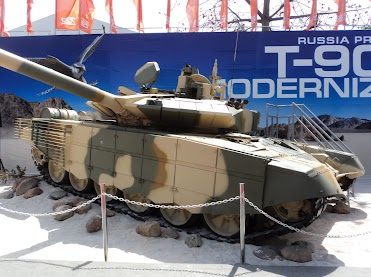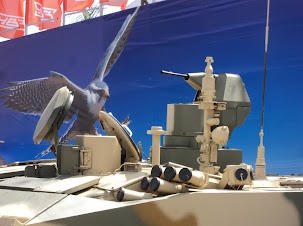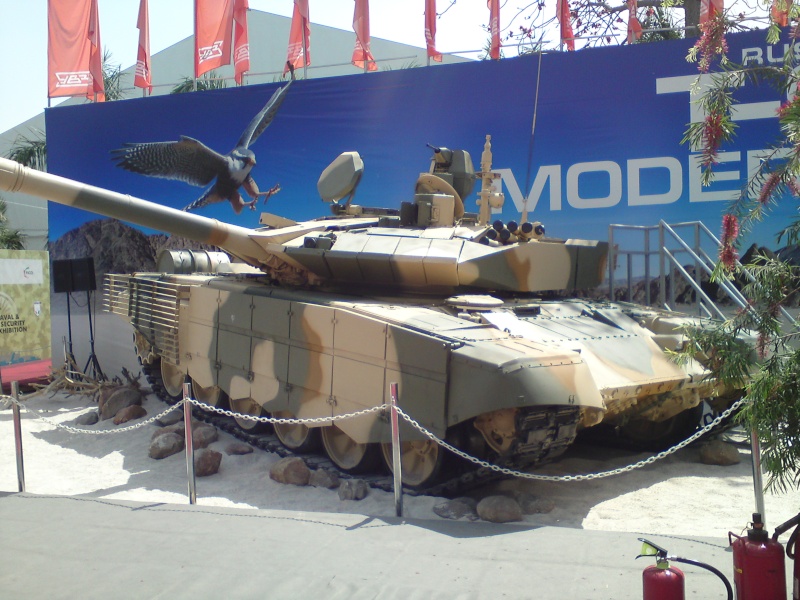


Just supplementing the initial pics in this thread with some pics of the T 90 MS during Defense Expo (India)last March





Zivo wrote:Notice that the two bins on the back are angled to cover the majority of the side and rear of the tank, while the two front bins are angled to densely cover the frontal arc.
In combat the turret will most likely be facing the direction of the threat, and the T-90s laser warning system should angle the turret if a designator or rangefinder paints the T-90's flank. IMO it's a good setup, most of the ammunition and coverage for the APS will be concentrated on the frontal arc. The two rear bins should be adequate with three rounds each at protecting the flanks in an ambush scenario. After all, in most cases they will only have to defeat one round before the turret rotates to return fire.

No it’s not going to happen. All the Ammo cassettes need to be ready to launch at all time.GarryB wrote:We have to keep in mind that this is an upgraded system, the first of which only covered the front hemisphere. This second iteration gives full 360 degree coverage. The question I have is can those layers in the bins be stacked, and if they can then I would suspect that each bin has one munition place that covers 30 degrees and perhaps with 3-4 layers it should offer reasonable protection from any angle.
The Trophy is built this way. After each shoot an automatic loader will put a new interceptor in place.Remember a modern system like Trophy offers two interceptor rockets so it can engage two threats and then it is empty.
Yes it could be a good idea, but if the turret gets hit, it might ignite the ammo cassette which will not be nice. Maybe that was the reason to move them to bin silos.I like the idea of fixed munitions that detonate at a specific distance from the vehicle to intercept threats... is it simple and cheap and apparently effective.
To be honest when I first saw the original Arena I wondered if the array of munitions around the front of the turret could be fitted in double or triple layers too.
no doubt about that.I liked the idea that the munitions were launched up to fire down into the ground to minimise the danger to nearby friendly troops and I also liked the fact that they could be manually set off to deal with enemy troops that managed to get close to the tank.
This new system with 360 degree sensor coverage and we assume 360 degree munition coverage appears to be a much better system, yet it likely retains the problems with the original system in that it likely does not deal with diving top attack munitions.
That is OK as far as I am concerned this upgrade is a good step in the right direction.
The new APS systems Standard and Afghanistan are supposed to be able to intercept APFSDS rounds and I look forward to seeing the solutions they have used for this very difficult task.
No it’s not going to happen. All the Ammo cassettes need to be ready to launch at all time.
The Trophy is built this way. After each shoot an automatic loader will put a new interceptor in place.
The loading will take 1 second and the unit is ready to shoot again.
Yes it could be a good idea, but if the turret gets hit, it might ignite the ammo cassette which will not be nice. Maybe that was the reason to move them to bin silos.

Why?No it’s not going to happen. All the Ammo cassettes need to be ready to launch at all time.
One more option that looks more logic to me, is to allow the rear bins to turn right and left so they can cover all the rear and side areas, and pace the treat in 90 degrees which the ammo will be most efficient.If there are four fixed launchers and in each launcher there are three interceptor munitions, it is fairly safe to assume either each munition follows a specific path to cover one particular sector with all 12 munitions covering the full 360 degrees or that each munition has a very wide angle of interception so there is already three munitions covering attacks from that direction.
If you mean to store 3 cassettes on each other, I don’t think it can be done. It’s to complicated, you have to shoot the cassette out and when explosive involved to eject this cassettes, it’s get complicated.If you stack three extra layers of munitions on top then each of the four munitions would cover the same sector so having three munitions on top of the bottom one doesn't mean its sector is not covered till the three munitions on top of it are fired. It means that the sector that munition position covers is covered by 4 separate munitions so there are four shots that can be launched before there is a hole in the defence.
The Trophy is built this way. After each shoot an automatic loader will put a new interceptor in place.
The loading will take 1 second and the unit is ready to shoot again.
I’m sure our enemy would like to know the answer for that too. I don’t have answer to that, but I think the soft kill will take care of that.So what is it going to do with Kornet, which even in the old standard model can launch two missiles guiding on the same laser beam that fly within 20-30m of each other.
AgreedAlso claiming to be the first active protection system is a lie, as I have mentioned Drozd-1 and even Shater from the 1970s preceded the Trophy by several decades.
Yes it could be a good idea, but if the turret gets hit, it might ignite the ammo cassette which will not be nice. Maybe that was the reason to move them to bin silos.
I think you right and it’s not safe to keep the old arrangement and ERA together, and that’s maybe why they change the concept.I would expect the munitions cassettes would be as insensitive to enemy fire as ERA blocks are.
I rather suspect the grouping of the munitions into bins could either be so they could be stacked in layers to offer more persistent protection, or perhaps make reloading easier and simpler... it also frees up access to ERA blocks which makes them easier to change too.
One more option that looks more logic to me, is to allow the rear bins to turn right and left so they can cover all the rear and side areas, and pace the treat in 90 degrees which the ammo will be most efficient.
If you mean to store 3 cassettes on each other, I don’t think it can be done. It’s to complicated, you have to shoot the cassette out and when explosive involved to eject this cassettes, it’s get complicated.
I’m sure our enemy would like to know the answer for that too. I don’t have answer to that, but I think the soft kill will take care of that.
AJ-47 wrote:Zivo wrote:Notice that the two bins on the back are angled to cover the majority of the side and rear of the tank, while the two front bins are angled to densely cover the frontal arc.
In combat the turret will most likely be facing the direction of the threat, and the T-90s laser warning system should angle the turret if a designator or rangefinder paints the T-90's flank. IMO it's a good setup, most of the ammunition and coverage for the APS will be concentrated on the frontal arc. The two rear bins should be adequate with three rounds each at protecting the flanks in an ambush scenario. After all, in most cases they will only have to defeat one round before the turret rotates to return fire.
I can't agree on that. It's maybe true in a tank to tank fighting, but not in a urban fighting. The enemy will not fire RPG or ATGM to your front, they will fire on the sides and the rear of the tank.
The laser receiver will not give you enough warning time, because the laser beam will not be on the tank for most of the missile flight, it will point to a close point to the tank, and only at the last seconds of its flight, it will point on the tank itself.
The 3 explosive cast in the front bin are looking to the same direction and can cover 30 degrees from each side of the gun. The rear bin can’t cover the rest of the area, so IMO the rear bins can swing right and left to cover 360 degrees. By doing that the 2 rear bins can help each other and put 6 casts for each side of the tank, and most importent they will stand in 90 degrees to the missile to make the most of the warhead.

One more option that looks more logic to me, is to allow the rear bins to turn right and left so they can cover all the rear and side areas, and pace the treat in 90 degrees which the ammo will be most efficient.
That adds too much complication, you will need motors to turn the bins and recording devices to monitor where they are currently facing.
It makes more sense to me to simply design the munitions to jump out of the bin at a specific angle to cover a specific sector.
The munitions bound up using a small propellent charge without doing very much damage to the thing they are sitting on. That would not detonate the munition below it so stacking 3-4 on top of each other would not be a problem.
that's true, but the ADS will make any attack more complicated and more costly to the attackers.There is no such thing as an invulnerable tank. The enemy can simply use more RPGs at once from a range of different angles.

Tanks in urban fighting will stay 2 km away and give support to the troops with there big guns.medo wrote:Arena or Trophy or any similar protecting system is good thing to have, but not for every environment. In an open battlefield, where tanks and IFVs drive fast in charge without infantry, such protection is excellent against ATGMs. But in urban battlefield, where tanks go slowly with infantry support, which is close to tank because of little space, this kind of protection will make more harm to protecting infantry that to protect tank.

That's all true, but the only thing that's important is the coverage of one cassette, the rocket from the DROZD system can cover 20 dgrees area, evendue it's not the same warhead, I don't think that the rear bins can cover the side and the rear without have the option to rotate itself.Zivo wrote:AJ-47 wrote:Zivo wrote:Notice that the two bins on the back are angled to cover the majority of the side and rear of the tank, while the two front bins are angled to densely cover the frontal arc.
In combat the turret will most likely be facing the direction of the threat, and the T-90s laser warning system should angle the turret if a designator or rangefinder paints the T-90's flank. IMO it's a good setup, most of the ammunition and coverage for the APS will be concentrated on the frontal arc. The two rear bins should be adequate with three rounds each at protecting the flanks in an ambush scenario. After all, in most cases they will only have to defeat one round before the turret rotates to return fire.
I can't agree on that. It's maybe true in a tank to tank fighting, but not in a urban fighting. The enemy will not fire RPG or ATGM to your front, they will fire on the sides and the rear of the tank.
The laser receiver will not give you enough warning time, because the laser beam will not be on the tank for most of the missile flight, it will point to a close point to the tank, and only at the last seconds of its flight, it will point on the tank itself.
The 3 explosive cast in the front bin are looking to the same direction and can cover 30 degrees from each side of the gun. The rear bin can’t cover the rest of the area, so IMO the rear bins can swing right and left to cover 360 degrees. By doing that the 2 rear bins can help each other and put 6 casts for each side of the tank, and most importent they will stand in 90 degrees to the missile to make the most of the warhead.
SALH missiles which are common in NATO arsenals require the target to be continuously painted by a designator to be effective. If the reflection of the laser radiation off the target is not picked up by the projectile's seeker, it will simply continue on its original path and miss the target. Laser rangefinders will also trip the T-90's warning system. Only beam riders operate the way you stated, and are well known not to trip laser warning systems. The MMW radars can also angle the turret towards the threat, but it will only be able to react after the first shot is intercepted.
All of these factors will put the brunt of the APS ammunition drain and coverage demand on the two front bins. Regarding coverage arcs, your guess is as good as mine as to how large the fragment cloud from the new ARENA is, but the layout indicates they are rather wide.
Tanks in urban fighting will stay 2 km away and give support to the troops with there big guns.
That’s the problem. How do we design the cassettes to do that? It will be much easier to turn the bins, it will not be more complicated than turn the RWS on the turret of the T-90.
The Arena IMO operated in very simple way; the bin will launch the cassette in the same direction, to the same range, in the same elevation, and will always detonate the cassette at the same distance from the tank. The computer will have to calculate the timing for the launch.
There is one big different between claymore and RPG, claymore need to hit people and the system will spread the fragments on a larger area, to shoot dawn RPG you need to concentrate the splinters so they will do serious damage to the RPG and drove it down. So the arc will be no more than 10 degrees each side.
That’s good to know, but the bins are not deep enough to except more then one cassette in depth.
that's true, but the ADS will make any attack more complicated and more costly to the attackers.
Tanks in urban fighting will stay 2 km away and give support to the troops with there big guns.
For the fighting zone, hybrid vehicle with the turret of the BMP-3 and the T-72 chassis, plus RWS with 14.5mm HMG will be the right one. The best vehicles in the urban fighting is the D-9s. In any case soldiers shouldn’t be to close to vehicles with ERA or ADS.
Look at the dust kicked up from the fragments hitting the ground, you can clearly see just how wide ARENA's fragment cloud is. There's a reason ARENA was deemed "to dangerous for infantry" by the west.
Actually in urban area it is infantry, who protect tanks against AT teams.

Again, I didn’t see any evidence that the arc is let say 60 degrees, the video is nice, but I can’t learn much about the coverage. I do know that the DROZD’s rocket has 20 degrees opening and they are 17 kg rocket. So the best I can give the Arena’s cassette is 30 degrees. But even with 60 degrees you can’t defend the sides of the tank unless you turn the rear bins.Zivo wrote:Watch the test 30 seconds into this video.
Look at the dust kicked up from the fragments hitting the ground, you can clearly see just how wide ARENA's fragment cloud is. There's a reason ARENA was deemed "to dangerous for infantry" by the west.

Tanks in urban fighting will stay 2 km away and give support to the troops with there big guns.
120mm mortar are very welcome in the fighting. Tanks, mortars, rockets will be enough in the fight.In that case it's better to use artillery outside the town. Tanks are in the same line as infantry to support them and to give cover if needed.
The D-9 will do much better job.Also tanks are strong enough to crash a building if it is necessary.
No doubt, in the fighting some time the tanks will lead, and some time the infantry will lead.The problem is, that tank need space to rotate the turret, what in small streets is not always given and infantry will be also close to tank. Actually in urban area it is infantry, who protect tanks against AT teams.
|
|
|